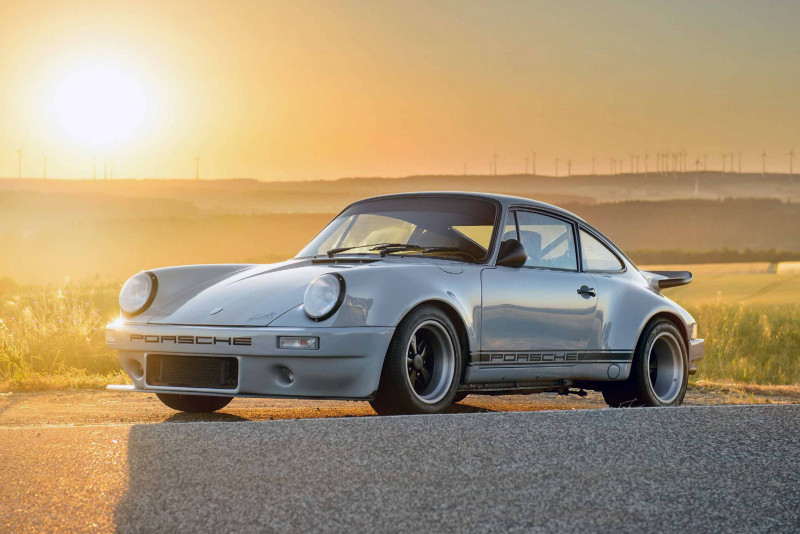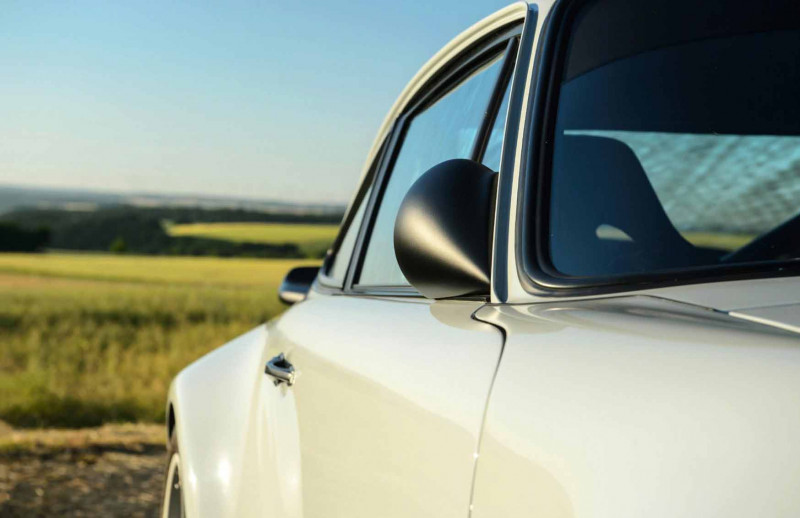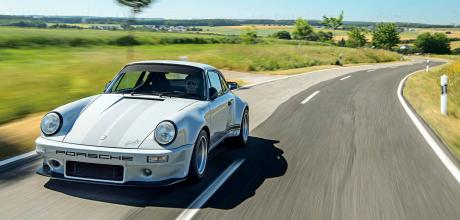Emmerling 1978 Porsche 911 RSR Evocation, G-model basis
Starting life as a ’78 SC, this rip-roaring G-series has grown into a fire-breathing, RSR-inspired restomod. Total 911 puts it to the test… Written and Photographed by Steve Hall.
RSR restomod
Steve Hall brings you the brilliant build of this firebreathing. RSR restomod from a ’1978 SC base
I wonder if the folks at Porsche realised just how iconic the Rennsport models would become nearly 50 years later? Barely ten years since the inception of the 911 and the world was blessed with what for many remains the iconic 911, in 1973’s 2.7 RS. Starting a family bloodline that would go on to deliver some of the most valuable, desirable and downright fabulous-to-drive 911s that have ever existed, I guess we should be thankful for Porsche’s desire to go motor racing to prove its mettle.

And as if the wonderful 2.7 RS wasn’t enough, that difficult second album delivered in spades with the 3.0 RS a year later – costing almost twice as much as the 2.7, it brought more power, less weight and 917 brakes to deliver an even more track-focused 911 experience. Both models spawned hardcore RSR versions, the 2.7 RS siring the 2.8 RSR, which would go on to score victory in its very first race at the 1973 Daytona 24hrs – the engine running for six hours longer than it ever had in testing! The 3.0 RS proved a stunning base for the 3.0 RSR. Principally developed for the inaugural IROC Championship, it went on to score major success in everything from the Targa Florio road race to Group 4 sportscar racing. It also brought us the first look at an aesthetic addition that would come to define the poster book vision of the 911 for decades to follow – the whaletail spoiler. Just two years from the first Rennsport, we already had four stunning iterations laying the foundations of those iconic sportscars we now look back at with such adulation. Every one of them an absolute stunner, offering varying degrees of delicacy, purity, purpose and downright aggression.
It’s no wonder that when the restomod scene started to gather pace, these cars provided the template for a look that so many were hungry to emulate – arguably there’s never been a better-looking 911 generation, so reimagining (as Singer would have it) one of the original 911 RS/R family through the prism of modern technology is a logical path to follow. It helps too that the 964 chassis so often used for these recreations retains the ideal proportions and compact size that made the originals so ‘right’.

Which only makes it all the more interesting that the car we’re driving today started life as a 1978 G-model, eschewing the seemingly standard template for restomod nirvana. Furthermore, taking its aesthetics from the most hardcore of the lot – the 3.0 RSR – follows a path less trodden, but as we’ll find out when we drive it later, choosing the most aggressive look is entirely appropriate given its dynamic makeup. Why start with a G-body 911?
Simple, really – quite apart from wanting to remain as faithful to an old-school driving experience as possible, the G-body is lighter than the 964. And whilst this car has been given the moniker ‘Sport Classic’ to reflect its intended fast touring role, keeping the car light, strong and quick was a key part of the philosophy during its build, so every kilo saved is worthwhile.
I know I banged on about great-looking 911s in last month’s mag (to be fair, that ST is one of the all-time beautiful 911s), so forgive me for going down the same avenue here – I’m sure you’ll understand. This RSR evocation, whilst lacking the delicacy of line, lightness of touch and purity of the earlier RS models, just looks so damned purposeful with its signature whaletail spoiler, deep front air dam and wickedly flared arches hunkered over fat rubber. Detail touches like the tiny aero mirrors, inset gauze in the lower valance and the recessed front driving lamps combine to create a visual identity that tells you this is a serious driving weapon.
Climb inside and you’re left in no doubt. The interior is best described as ‘functional’, which might sound like (being damned by) faint praise, but is something I find enormously appealing for its utter lack of pretension – as with the exterior, the aesthetics work their way into your psyche so that you’re left with precisely the right impression before you’ve even twisted the key. Produced by the little known workshops of Heinz Emmerling west of Frankfurt, this car – like all his cars – is absolutely focused as a machine built for the pleasure of driving, devoid of extraneous fripperies which add nothing to the dynamics but plenty to the bottom line. I can appreciate the jewel-like finish and beautifully wrought addenda of a Singer as much as anyone, but there’s just something deeply appealing about a car built to this mantra, where you know that the money is in the oily bits, the interior dressed with the best where it matters – the rest very much ’70s 911.
So you drop yourself into fixed back Recaro carbon bucket seats, lightly padded in all the right places, tastefully trimmed in checkered cloth. The angle of the seat back is just about perfect for fast road driving, not so upright that you feel you’re readying yourself for a stint in the Nürburgring 24hrs, but not so reclined you can’t rest your wrists atop the wheel. I feel instantly comfortable, the deep bolstering helping me feel properly connected to the car. Right in front there’s a lovely leatherbound three-spoke Momo Prototipo wheel (one thing Emmerling does agree with Singer on…) to guide the RSR, rim thickness and diameter perfectly judged for a car with unassisted steering but a mere 363kg over the front axle. The pedals are a little offset – as per all G-model 911s – but the relationship between the pedal weight and heights are spot on for rev matching, whilst the gear lever is a bit of a stretch with the odd gears requiring a lean forwards (the throw being relatively long). Folks shorter of leg than my 6”1 frame (which dictates I have the seat right back on its runners) might find it just fine, but either way it’s second nature after a few kms and you find yourself flicking between third and fourth most of the time anyway.
Scanning the rest of the cabin, well, there’s not an awful lot to say. It’s simple, basic, G-series 911 but for the addition of a big red oil pressure warning light where you might expect to find a clock, nestling in the rightmost quadrant of the instruments where its size and proximity to your peripheral vision make it impossible to ignore (wise, given its purpose). There’s no radio (which would be fairly redundant anyway), the glovebox is lidless, the doorcards simple pieces of material with a handle. Such is the pursuit of light weight and simplicity it’s a surprise to find electric window switches instead of winders. I love it.
That pursuit of lightness is a triumph. The body is stripped bare and KTL primed, a process that saves a few grams over the factory method whilst ensuring solid protection for years to come. Insulated with ultra light materials, side and rear glazing thinner than standard, all these basics combine with the lightweight seats and doorcards to help deliver a kerb weight just 600g the wrong side of a ton. Is now a good time to mention this car has a 300bhp flat six…?
So yeah, classic look or not, it goes down the road really rather well. Endowed with a power to weight ratio superior to the modern ‘Sport Classic’ 997 (which has 102bhp more, but carries an extra 425kg) it absolutely flies once you’ve wound some revs onto the motor. And because it’s so light, so raw, so loud, the sensory assault on your mind convinces you it’s much faster than that rapid, but by comparison, limousine-like 997 Sport Classic. Interesting too that its 300bhp output is within touching distance of the original 3.0 RSR race car of ’74 whilst carrying only 100kg extra in concession to the fact it’s a road car which will (hopefully) do proper mileage. The motor is sensational; shorn from its previous home in the rump of an early 993 Carrera, it’s been uprated with hotter cams, the lack of VarioRam on the earlier M64/05 motor delivering a rev-hungry power curve that builds to a fantastic crescendo as the tacho winds its way beyond 5,000rpm.
Now we need to talk the sheer aural assault this thing creates, because the soundwaves hitting you from the back of this 911 when you’re ‘on it’ are something else. It may not be a ‘real’ 3.0 RSR but this 993 engine with its lumpy cams and free-breathing exhaust do a fine impression of the ’70s racer. In a nod to its ‘Sport Classic’ philosophy, it’s actually reasonably muted when cruising, the background bass throb of the flat six always audible but not intrusive – just always ‘there’ reminding you of the serious nature of what’s available under your right foot. But hit some proper roads where you can exercise the upper end of the rev range and the sound transforms, a deep melodious throb from 3,000rpm morphing into a sharp, serrated bark as you home in on the redline, loud enough that you feel trapped in an engine test room, but happy for the experience. It’s strange how charmed us humans are by something as simple as a sound, but it’s undeniably an utterly compelling part of interacting with a sports car like this. We’re going to miss it once EVs rule the roost. We’re on good roads today, the opportunity to extend that fabulous motor arising time after time, tight switchbacks interspersed with longer, more open corners to give the chassis a workout.
Germanically well surfaced and virtually bump free, it’s a fine place to explore the dynamics of the Sport Classic. It’s the steering that you notice first, inevitably. Devoid of assistance, there’s a high-fidelity stream of feedback coming at you even on these smooth roads, the light nose bobbing and weaving in classic 911 fashion, whilst the Momo weights up beautifully as soon as you tip it into a bend. The weight increases in linear fashion, the wheel writhing lightly in your hands, the merest hint of understeer in a tight, second-gear bend telegraphed by an instant decrease in resistance. It’s confidence inspiring.
So I feel buoyed to start pitching it into faster bends off throttle, gently trail braking it into my imagined apex to nail that lightly laden nose to the ground, the whole car feeling on its toes as each command is transformed directly into a swift change of direction. On its 285/40/ZR15 rubber, the rear feels pretty much nailed to the road, weight transfer on exit just adding grip as 300bhp loads up the rear axle. It’s grippy, immediate, and utterly intoxicating. The four-piston calipers feel like they’re having an easy time of it, such is their immediate response and rock-solid pedal feel; that lack of weight helping again. Whilst obviously not as useable as the 997 Sport Classic the colour scheme evokes, this would be an absolutely fabulous weapon to do a road trip in, delivering a vast smile when the roads turn interesting. None of this comes as a surprise to me; I’ve been lucky enough to sample a few of Emmerling’s cars now and whilst possessing differences in style and intended use, they’ve always had an absolute focus and dynamic coherence that puts driving pleasure front and centre.
A tour of the fine details of the spec sheet hints at the depth Emmerling goes to; the 110L fuel tank may impose on luggage space (of which there’s plenty behind the seats anyway) but doubles down on the fact it’s designed to be driven. The rear half cage and club sport front strut brace stiffen the shell, so Bilstein struts have a solid platform to work from.
Everything is lightweight but reliable, and it’s as thorough as you could ever dream – it’s both unfortunate and part of the appeal that they remain such rare jewels, a mere handful having left the West German workshops. In truth, this ‘Sport Classic’ is that in name only – rawer than anything else to have worn the badge, straddling a line that’s more RSR than RS. And whilst an original RSR would set you back enough to dissuade you from using it, this modern facsimile delivers its own take on the driving experience – and all of the stunning look – at a price the merely wealthy could make peace with.
Thanks With thanks to Heinz Emmerling and Rainer Schlumberger for their help with the shoot. Enquiries: schlumbergerainer@googlemail.com
“Choosing the most aggressive look is entirely appropriate given its dynamic makeup”
LEFT Purposeful interior includes buckets, a MOMO Prototipo, and deletion of radio and glove box cover.
RIGHT Slim mirrors are offset by wide, RSR-style hips.
- Emmerling 911 RSR Evocation, G-model basis
- Year 1978
Engine
- Capacity 3,600cc
- Maximum power 300bhp @ 6,500rpm
- Maximum torque 325Nm @ 5,000rpm
- Transmission Type 915, 5-speed manual, dogleg
Suspension
- Front McPherson struts, torsion bar, anti-roll bar
- Rear Semi trailing arms, torsion bar, anti-roll bar
Wheels & tyres
- Front 9x15-inch 225/50/ZR15
- Rear 11x15-inch 285/40/ZR15
Dimensions
- Length 4,291mm
- Width 1,795mm
- Weight 1,000.6kg
Performance
- 0-62mph 4.7secs (est)
- Top speed 160mph (est)


